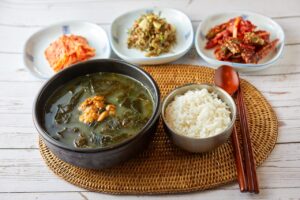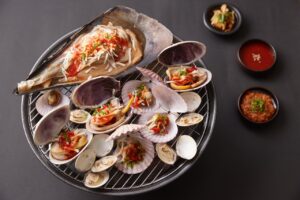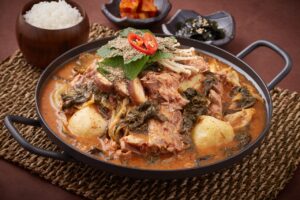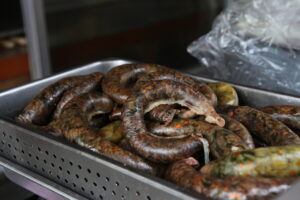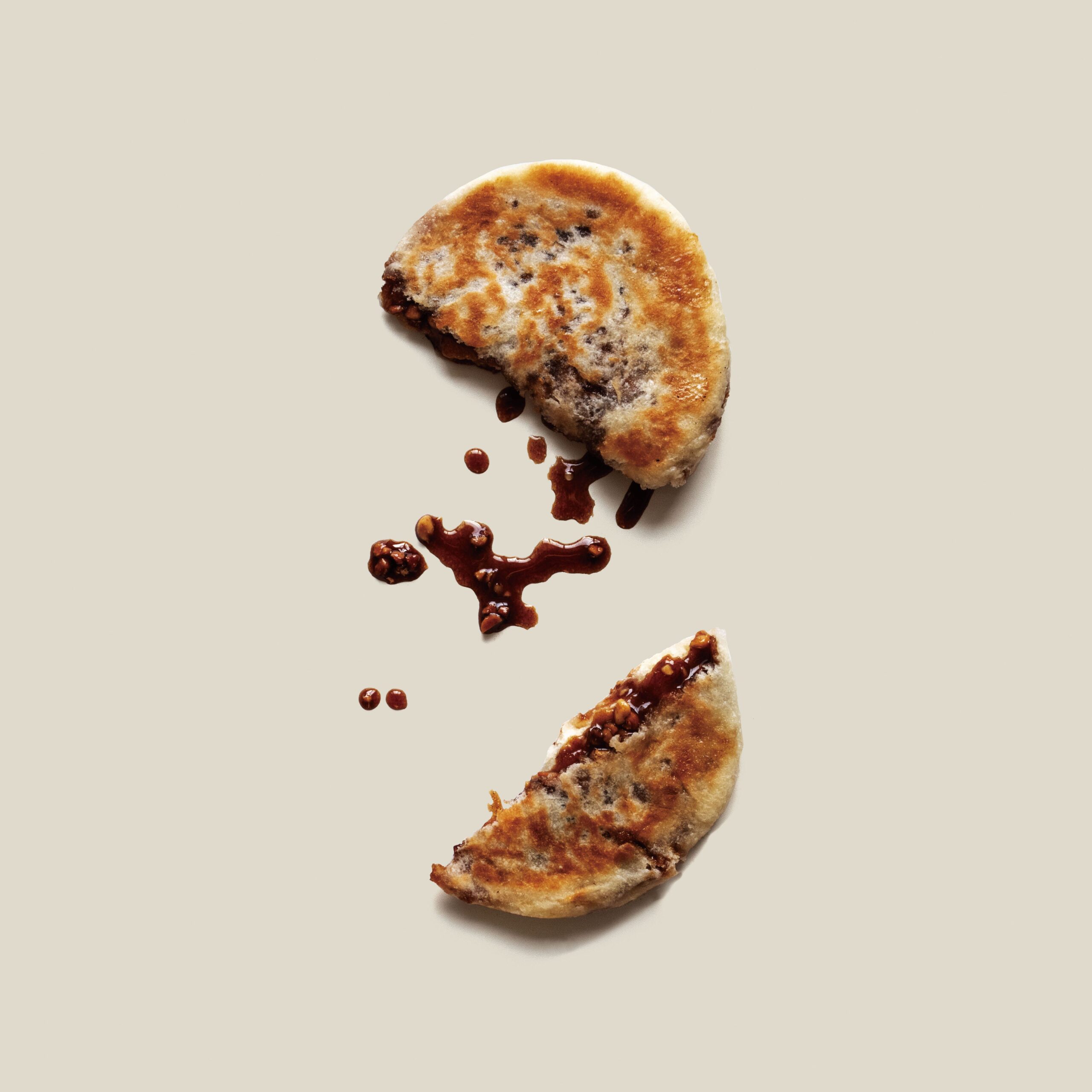
Hotteok (호떡) is a popular and beloved Korean street food and snack. It’s a type of sweet pancake that’s typically filled with a mixture of brown sugar, cinnamon, and chopped nuts. Hotteok is known for its crispy exterior and gooey, sweet filling, making it a delightful treat, especially during the colder months. Here’s more information about Hotteok:
History
Hotteok (호떡) is a popular Korean street food and snack that consists of sweet pancakes filled with a mixture of sugar, cinnamon, and chopped nuts. The history of hotteok dates back many years and is closely tied to Korea’s culinary traditions. Here’s a brief overview of the history of hotteok:
Historical Origins: The exact origins of hotteok are not well-documented, but it is believed that the dish has a long history in Korea. Hotteok’s sweet and doughy nature made it a favorite treat for Koreans, and it likely evolved over time based on the available ingredients and culinary influences.
Traditional Ingredients and Preparation: Traditional hotteok is made by kneading wheat flour dough, filling it with a mixture of sugar, cinnamon, and chopped nuts (such as peanuts or seeds), and then pan-frying until golden and crispy. The filling becomes gooey and flavorful when cooked, creating a satisfying contrast with the outer dough.
Seasonal Significance: Hotteok has been associated with various holidays and occasions in Korea. For example, it was traditionally enjoyed during winter as a warming treat. The rich and sweet nature of hotteok makes it particularly appealing in colder months.
Street Food Culture: Over the years, hotteok has become a popular street food in Korea. Vendors set up stalls or carts in busy areas, where they prepare hotteok fresh for customers. The enticing aroma of cooking hotteok and the sight of its golden exterior attract locals and tourists alike.
Modern Variations: While traditional hotteok remains popular, there are now various modern variations available. Some include different fillings like cheese, chocolate, red bean paste, and even savory options. These adaptations cater to changing tastes and preferences.
Cultural Significance: Hotteok holds cultural significance beyond its culinary appeal. It represents comfort, nostalgia, and the joy of enjoying simple pleasures. It’s a favorite among people of all ages and is often associated with childhood memories and special moments.
Influence on Pop Culture: Hotteok’s popularity has extended to pop culture as well. It has been featured in Korean dramas, variety shows, and even K-pop songs, contributing to its status as an iconic Korean snack.
In summary, hotteok’s history is deeply rooted in Korean culinary heritage, and it has evolved over time to become a beloved street food enjoyed by generations. Its delicious flavors, gooey texture, and cultural significance have secured its place as a cherished treat in Korea’s culinary landscape.
How to make Hotteok?
Ingredients:
- Dough: The dough for Hotteok is made with a mixture of flour, water, yeast, sugar, and a pinch of salt. It’s similar to regular pancake batter but slightly thicker.
- Filling: The classic filling consists of a mixture of brown sugar, cinnamon, and chopped nuts. Common nuts used include peanuts, walnuts, or sunflower seeds.
Preparation and Cooking:
- Making the Dough: The dough is prepared by mixing the ingredients together and allowing the dough to rise for a certain period, usually around 30 minutes to an hour.
- Preparing the Filling: The filling mixture is made by combining brown sugar, ground cinnamon, and chopped nuts. The sugar and cinnamon create a deliciously fragrant and sweet-spicy flavor, while the nuts add a satisfying crunch.
- Assembling the Pancakes: Small portions of the dough are flattened into circles, and a spoonful of the filling mixture is placed in the center. The edges of the dough are then sealed, enclosing the filling.
- Cooking: The filled dough is flattened and pressed into a disc shape, then pan-fried on a griddle or skillet until both sides are golden brown and crispy. As the sugar in the filling melts, it caramelizes, creating a gooey and sweet interior.
Serving: Hotteok is typically served hot off the griddle. It’s often enjoyed on the go as a street food, especially in outdoor markets or near schools. The contrast between the crispy exterior and the warm, gooey filling is a big part of what makes Hotteok so appealing.
Variations: While the classic brown sugar, cinnamon, and nut filling is the most common, there are also variations of Hotteok that offer different fillings, such as chocolate, cream cheese, sweet potato, or even savory options like kimchi and cheese.
Availability: Hotteok is especially popular during the winter months when the warm and comforting snack provides a delightful respite from the cold weather.
If you have the chance to try Hotteok, I highly recommend it! It’s a wonderful example of Korean street food that captures the balance between sweet and savory flavors, as well as different textures.
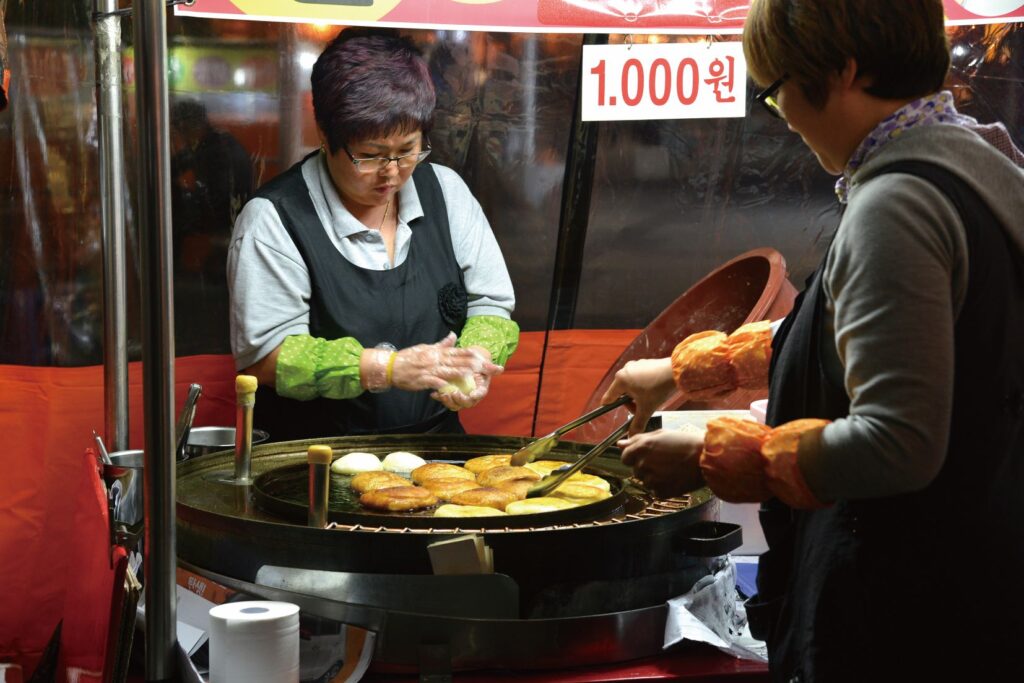

Famous Place in Korea : SAMCHEONGDONG Hottoek
Address : 82-6, Yulgok-ro 3-gil, Jongno-gu, Seoul 03061 South Korea
Recommend to Read >> Jjajangmyeon, Korean Black Noodle Aug, 2023.

